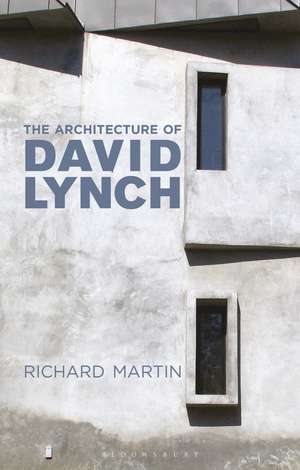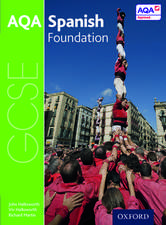The Architecture of David Lynch
Autor Richard Martinen Limba Engleză Paperback – 2 oct 2019
| Toate formatele și edițiile | Preț | Express |
|---|---|---|
| Paperback (1) | 192.30 lei 6-8 săpt. | |
| Bloomsbury Publishing – 2 oct 2019 | 192.30 lei 6-8 săpt. | |
| Hardback (1) | 774.62 lei 6-8 săpt. | |
| Bloomsbury Publishing – 22 oct 2014 | 774.62 lei 6-8 săpt. |
Preț: 192.30 lei
Preț vechi: 249.87 lei
-23% Nou
Puncte Express: 288
Preț estimativ în valută:
36.80€ • 39.35$ • 30.68£
36.80€ • 39.35$ • 30.68£
Carte tipărită la comandă
Livrare economică 17 aprilie-01 mai
Preluare comenzi: 021 569.72.76
Specificații
ISBN-13: 9781350146792
ISBN-10: 135014679X
Pagini: 248
Ilustrații: 62 colour and 14 bw illus 32pp colour plates
Dimensiuni: 138 x 216 mm
Greutate: 0.39 kg
Editura: Bloomsbury Publishing
Colecția Bloomsbury Visual Arts
Locul publicării:London, United Kingdom
ISBN-10: 135014679X
Pagini: 248
Ilustrații: 62 colour and 14 bw illus 32pp colour plates
Dimensiuni: 138 x 216 mm
Greutate: 0.39 kg
Editura: Bloomsbury Publishing
Colecția Bloomsbury Visual Arts
Locul publicării:London, United Kingdom
Caracteristici
Key architects such as Rem Koolhaas, Le Corbusier, Adolf Loos, Richard Neutra, Jean Nouvel and Frank Lloyd Wright
Notă biografică
Richard Martin is Curator of Public Programmes at the Tate, UK, and a tutor at the Bartlett School of Architecture, UCL, UK. He completed his PhD at Birkbeck, University of London, UK having previously worked at the Commission for Architecture and the Built Environment (CABE). He has taught at Birkbeck, Middlesex University and Tate Modern.
Cuprins
Prologue: Three JourneysIntroduction: Mapping the Lost Highway1.Town and City2.Home3.Road4.Stage5.RoomAcknowledgmentsNotesImage CreditsWorks CitedIndex
Recenzii
A thoughtful exploration of Lynchian space, The Architecture of David Lynch ... [provides] a wealth of architectural readings, a diverse bibliography, and a wonderfully insightful analysis of Lynch's filmography that inspire and enrich re-viewings.
Architecture is more central to the cinema of David Lynch than that of any other film-maker, and now a book finally exists that not only grasps architecture's significance for Lynch but shows that it is impossible to understand these films without a thorough knowledge of the role that architecture plays in them. Martin's book is godsend for anyone with even a passing interest in David Lynch or the relationship between architecture and cinema. He bombards us with insight after insight.
In this important and original study Richard Martin explores connections between the cinema of David Lynch and a series of distinctive urban spaces, drawing on insights from architectural history, cultural geography and contemporary film theory.
While David Lynch's admirers have long marvelled at his talents as an engineer of atmosphere, the director's architectural thinking has not received the scholarly attention it deserves. The Architecture of David Lynch is thus a welcome study. Brimming with insight and intelligence, this book inhabits the obsessive spatial topoi of Lynch's films, and finds there the traces of history. In Martin's fascinating account, Lynch's moody architecture is a way of engaging modernity's built environments through the kinds of spaces that only cinema can fashion.
The reviewer commends the author on the work's intelligence and insightful considerations of Lynch's use of space, place and architecture in his films... With an impressive bibliography and 62 color plates of film stills, reproductions of paintings, and photographs of filming locations, the book is an important contribution to Lynch scholarship and engages film scholars to consider the dynamics of space, place and architecture in cinema... Martin's text effectively joins the canonical works of Lynch scholarship, while simultaneously forcing all film scholars to re-evaluate the impact, effect and importance of space, place and architecture in film.
Incisive and highly readable... Martin finds solid rhetorical ground and a plethora of interdisciplinary source material from which to articulate astonishingly deep, intricate, and, yes, original readings of Lynch's work... The Architecture of David Lynch is clearly an indispensable entry in a densely analyzed field of film and auteur studies.
Martin's study is such an important addition to 'Lynch' studies, offering a unique analysis of Lynch's cinematic work through design and construction... Martin's particular, unique focus shows how architecture forces us to confront the strange within the urban and suburban, and the social forces at work in the use of architecture, essentially re-establishing and altering our conceptions of the everyday.
Architecture is more central to the cinema of David Lynch than that of any other film-maker, and now a book finally exists that not only grasps architecture's significance for Lynch but shows that it is impossible to understand these films without a thorough knowledge of the role that architecture plays in them. Martin's book is godsend for anyone with even a passing interest in David Lynch or the relationship between architecture and cinema. He bombards us with insight after insight.
In this important and original study Richard Martin explores connections between the cinema of David Lynch and a series of distinctive urban spaces, drawing on insights from architectural history, cultural geography and contemporary film theory.
While David Lynch's admirers have long marvelled at his talents as an engineer of atmosphere, the director's architectural thinking has not received the scholarly attention it deserves. The Architecture of David Lynch is thus a welcome study. Brimming with insight and intelligence, this book inhabits the obsessive spatial topoi of Lynch's films, and finds there the traces of history. In Martin's fascinating account, Lynch's moody architecture is a way of engaging modernity's built environments through the kinds of spaces that only cinema can fashion.
The reviewer commends the author on the work's intelligence and insightful considerations of Lynch's use of space, place and architecture in his films... With an impressive bibliography and 62 color plates of film stills, reproductions of paintings, and photographs of filming locations, the book is an important contribution to Lynch scholarship and engages film scholars to consider the dynamics of space, place and architecture in cinema... Martin's text effectively joins the canonical works of Lynch scholarship, while simultaneously forcing all film scholars to re-evaluate the impact, effect and importance of space, place and architecture in film.
Incisive and highly readable... Martin finds solid rhetorical ground and a plethora of interdisciplinary source material from which to articulate astonishingly deep, intricate, and, yes, original readings of Lynch's work... The Architecture of David Lynch is clearly an indispensable entry in a densely analyzed field of film and auteur studies.
Martin's study is such an important addition to 'Lynch' studies, offering a unique analysis of Lynch's cinematic work through design and construction... Martin's particular, unique focus shows how architecture forces us to confront the strange within the urban and suburban, and the social forces at work in the use of architecture, essentially re-establishing and altering our conceptions of the everyday.




















